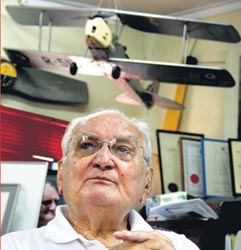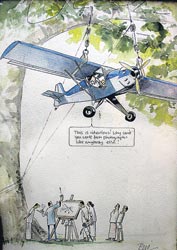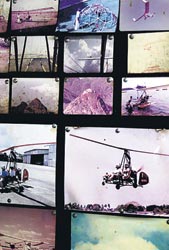
From plane to planeSurrounded by the memorabilia of his colourful life, 83-year-old Ray Wijewardene talks to Renuka Sadanandan and Kumudini Hettiarachchi of his lifelong passion for flying machines On a sunny morning in Colombo some two decades ago, passers-by were taken aback by the sight of a light aircraft making a steady descent towards the green in front of the Town Hall. As they watched open-mouthed, the aircraft landed and as the crowd grew, the pilot taxied smoothly onto Dharmapala Mawatha with his assistant trotting behind, holding on to the blades to prevent them turning. They made their sedate way amidst the traffic to the Red Cross roundabout and then turning right disappeared into a nearby house. “I had to answer a call of nature,” was what the pilot told a high-level Civil Aviation Authority inquiry appointed to find out why on earth anyone would land an aircraft at the Town Hall. “But it was something I always wanted to do,” he chuckles.
There are many such daredevil escapades that Ray Wijewardene can look back on. For though renowned as an expert in tropical agriculture and one of the country’s leading proponents of biomass energy, it is aviation that is his grand passion. A man must have his passions, he believes. He likes to describe aviation as the jam in his life and agriculture as the bread and butter. “You have to earn a living to feed your passion but you should never let your life’s dream go. Flying was always my dream. There’s nothing that gives you that same freedom. Up in the air, you’re flying with the birds, you’re one with nature.” In my previous birth I must have had wings, he muses, explaining how from his boyhood he would study the birds, the insects, the dragonflies which can even hover backwards, intrigued by these natural flying machines. His first flight was while still a schoolboy of 17 at S. Thomas College, Mount Lavinia where he had designed and built an aircraft himself at the school carpentry class and fitted it with his master’s motorcycle engine. During school one day, he left with his aircraft and pushed it all the way along the Galle Road with its wings folded to the Ratmalana airfield where he proceeded to attempt his first solo flight. It was then that realization dawned that there was more to flying than merely getting the aircraft into the air and that practice with a broomstick as a joystick would not suffice. The plane ran here and there, then took off and flew for a brief magical moment before careening over the coconut trees to crash into the pond at Sir John Kotelawala’s neighbouring Kandawela estate.
At Cambridge University, he studied aviation engineering, mechanical engineering and agricultural engineering and graduated in the tough times of the post-war era, to find that the new world of aviation that he aspired to had “fizzled out” in the wartime disillusionment. So he found himself a job as a machinist at the Volkswagen factory in Heidelberg, Germany where he was seated next to an elderly man the others would address as Herr Professor. It turned out that this man was a professor of anthropology who spent his days working at Volkswagen and his nights imparting his love for anthropology to his students. It was the young Ray’s first brush with “the two lives” and one that made a deep impression on him, so that all through the many twists and turns of his career in tropical agriculture and engineering, he made time for flying. The aircraft he designed are way too many and varied to detail here. Constantly driven to build something new, he used the Ratmalana airfield in the less security conscious days of the 60’s and 70’s to try out his experiments, taking off and landing his planes not on the runway but on the grass. “You had to pay landing fees if you used the runway,” he smiles. He also went hang-gliding at Foxhill on an ultra light craft made with chopper bicycle wheels and a Kawasaki engine. It had hammock seats and the petrol tank behind. The tubing he got from Panchikawatte and the entire craft could be handily folded and stowed away in the boot of a car. At other times, he flew a seaplane he had designed and built with floats made with foam rubber from Richard Peiris with fibreglass round it, to the Kalutara lagoon. Learning how to land in the water was quite tricky, he concedes. “To fly is easy,” he maintains, “But landing is the difficult thing.” Not all his flights had smooth landings. In 1988, flying south to Lunuganga to visit his friend Geoffrey Bawa in a microlight aircraft, he landed on the driveway only to have to take off hastily, having disturbed a “swarm” of bats from the nearby Na trees. “I misjudged the approach and descended on the roof but Geoffrey was very nice about it,” he recalls with a smile.
“In the days of World War 1 and 2, landing an aircraft was a difficult task. There was a saying that if you walked away from it, that was a good landing. Fortunately, I have walked away from all my landings.” Amazingly all his many aircraft were built in his own garage with his trusty staff working under his eagle eye, welding and soldering, making his design a practical reality, ever mindful that one mistake could be a matter of life or death. “I am my own test pilot, my own constructor, my own mechanic,” he says. Most of his inventions were built with locally available materials and when he did import blades for his helicopter powered by a Subaro car engine, they were the ones that broke! But far removed from those heady heights, Ray Wijewardene is also the man behind the pioneering design of a two-wheel tractor that revolutionized agriculture in Asia. This came after his Cambridge days when he took his design to the well-known engineering firm Land Master in Nottingham in 1955. They liked it but to his dismay told him that he himself would have to find the buyers before they could manufacture it. And so followed many travels to the East, countries like Japan, Malaysia, the Philippines. To his surprise, orders flooded in. Manufacture began and in a few years they had sold several hundred thousand tractors. Then followed a post-MBA at the Harvard Business School which awakened in him a new conviction on the fundamental differences between tropical and temperate agriculture, that he has pursued with enthusiasm all through his life promoting fuelwood alternatives and farming ‘nature’s way’, all of which he puts into practice at his estate in the Chilaw district. Today, at 83, he has just completed a five-year stewardship as Chancellor of the Moratuwa University. The memorabilia of his colourful life surround him, the model aircraft, the certificate he got for sailing at the Mexico Olympics and the silver medal at the 1968 Bangkok Asian Games-- all constant reminders of the many experiences that the fates have led him to. “Each experience is an arch through which you see another experience in front of you and each primes you for the next,” he says, reaching out to show us a framed photograph of the courtyard and arches of Peterhouse at Cambridge, quoting Tennyson’s evocative lines from Ulysses: “Yet all experience is an arch wherethro' His flying days may be over now, but passing from one arch to another, Vidya Jyothi Dr. Ray Wijewardene, is still raring to go. Days after our interview, he was busy steam-boating in the waters off Kochchikade, as if to reinforce the motto, displayed outside his office door -- ‘Old pilots never die, they just go on to another plane’. |
|| Front
Page | News | Editorial | Columns | Sports | Plus | Financial
Times | International | Mirror | TV
Times | Funday
Times || |
| |
Copyright
2007 Wijeya
Newspapers Ltd.Colombo. Sri Lanka. |


